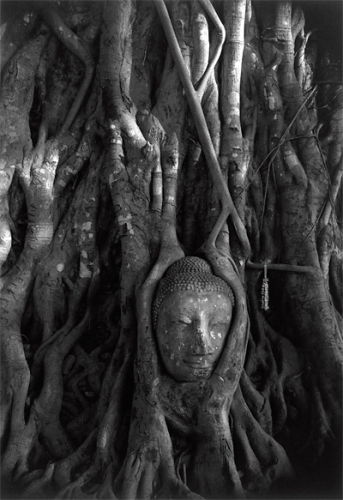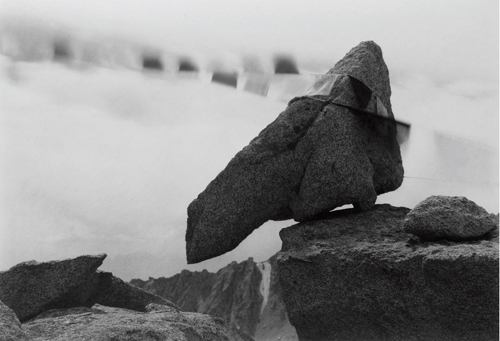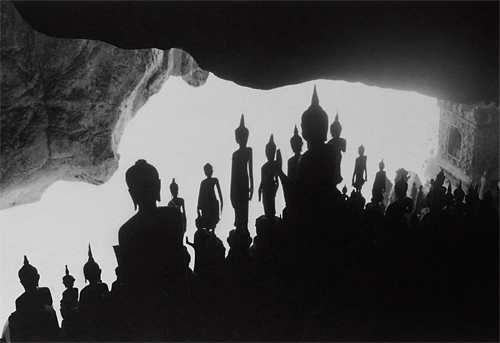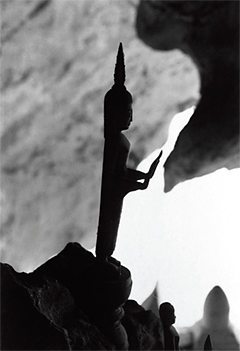Over the last half-century, Buddhist practices in the West have grown in popularity. Mindfulness has become associated with stress reduction, enhanced immunological protection, psychological well-being, and profound states of happiness. In many cases, mindfulness has been uncoupled from the Buddha’s teaching altogether and is a stand-alone cognitive therapy for the treatment of various mental difficulties, from depression to obsessive-compulsive disorder.
The term anatta, which means “no [permanently abiding] self or soul,” is at the heart of the Buddha’s teaching, but with our Western emphasis on psychological health it is perhaps inevitable that this essential aspect of the teaching is downplayed or even avoided. Emptiness, after all, stands in opposition to many of our most important values such as self-reliance, individual initiative, and the pursuit of pleasure. We want the contentment and happiness promised by the Buddha, but with “me” fully stabilized and intact.
This selective approach to Buddhism would seem to allow the best of both the Eastern and Western worlds. We can use the techniques and practices that serve our immediate purpose without asking the deeper spiritual questions concerning our very existence. Best of all, the methods work, and the benefits of greater mindfulness dramatically affect both our mental health and the ease of our life.
The story would end happily here, except that there is a rub when we pare back the dharma, the Buddha’s teaching. Externally we see the earth’s environment eroding before our eyes, the population soaring, and our natural resources diminishing. We see unparalleled greed and anger forming greater divisions within an evershrinking planet. At a time when the world pleads for kindness and compassion, we see cultures continuing their ancient bickering while forgetting their shared heritage.
Internally our problems continue as well. We hurt, and we do not understand why. Fear, desire, and grief fill our life. Our psychological sophistication should solve our problems, but therapies and self-improvement methods do not seem to diminish our isolation and separation. We would like to feel compassion for all beings, but our own problems are so demanding that we have little time to include others in our heart. We try to compensate for these shortcomings with more socially engaged activities, but we find that our motivation is often based in righteousness, which further divides the world.
Through all our techniques and procedures, the sense-of-I remains the cornerstone of our existence. When we look at our experience, we appear to be the center of the universe. All experiences seem to confirm our central place in life, and every input is interpreted through the lens of self. We hear about the corrupted power of the ego but seem unable to shake off this ever-present sense-of-me. Its authority seems absolute; most of us eventually acquiesce to its rule, and we engage our dharma practice carrying the sense-of-me along within our spiritual development.
Many of us incorporate a gentler and kinder spiritual “me” into our practice, which is in opposition to the worldly “me,” the troublemaking twin that needs a resolution. We then play the familiar theme of divide and conquer, pitting our spiritual ideals against our worldly reactions. Eventually we see that calling the ego different names serves to strengthen its overall grip and control, which inevitably leads to greater pain and ill will.
Some of us pursue the path of wisdom to weaken the ego’s influence, and we have genuine insights into the ego’s insubstantiality, but we may return from those revelations with the power and force of “me” very much intact. The ego has a way of claiming reference to its own demise by saying, “Oh, I just had an experience of my own emptiness.” No matter what we do, no matter how many revelations we have regarding our true nature, we still seem to organize the world around the basic premise that “I” am in here looking out at everything else. At some point the sincere dharma practitioner realizes that as long as the “I” is the governing force behind thoughts and emotions, then our internal world will be filled with abstract arguments and the external world will be laden with conflict and struggle. We begin to further understand that the cause of our suffering is not what we do but the way we perceive, and until this obstacle is addressed, all actions of body, speech, and mind will predictably reinforce our old perceptions of self and other, problem and solution, and limitation and freedom.

Spiritual practice is stepping out of the assumed reality of “me” by understanding what the “me” is and withdrawing energy from its perceptual fixations. The Buddha made the realization and integration of anatta central to his teaching—we are without separate existence; that is a fact. When we align all our practices and efforts with this fact, the spiritual path becomes quite simple and transforms everything we do. All the monasteries, renunciations, restraints, skillful means, full-lotus posture, and nose-tip awareness, all of it, has only this intended purpose. We must be very careful not to carry the assumption of separation to the practices that have the intended purpose of stepping out of self-deception. If we do, we will be reinforcing our egoic conditioning and move in the opposite direction from the freedom of the Buddha.
Much of my early practice carried this contradiction. My heart genuinely sought the truth, but I conceived of freedom as a very long and arduous process that needed focused determination and hard work. My efforts were directed toward surmounting myself. “I” was the problem, and “I” would apply effort toward resolving the difficulty of “me.” Often my teachers spoke of lifetimes necessary to achieve awakening and the long cultivation of mental qualities that freedom depended on. I thought of freedom as something that I was working toward but that was not accessible now.
After a few years of strenuous retreating, I ordained as a Buddhist monk and went on a pilgrimage to Bombay in January 1980, to visit the renowned sage Nisargadatta Maharaj. I had known of him years earlier through his book I Am That. After a few days of bantering back and forth about my attachment to being a monk, he said, “You are like a man holding a flashlight, trying to run beyond its beam. The view you are holding…is undermining your intent.” “You don’t understand Buddhism,” I retorted.
“You do not understand the truth,” he replied.
I was righteous, but he was right, and his message stuck. As the days unfolded, I lost my arrogance and my identification with the Buddhist robes, leaving me naked and exposed. By directly pointing to the truth, Nisargadatta destroyed my spiritual structure, purpose, and frame of reference. In their absence, something awoke with an upsurge of energy that seemed impossible to contain. It exploded with the revelation of what the Buddha was pointing to: The path that Nisargadatta revealed was not a search but a find, not a struggle but an abiding, not a cultivation but something intrinsic to all. I had been committed to the long-enduring mind of practice but not the essence, not the inherent freedom that was immediately available. From this vantage point, there seemed far too much methodology in the Buddhism I had been practicing and not enough release.

The Buddha’s Eightfold Path can either build upon or dismantle the sense-of-self, depending upon how we use it. When aligned within its proper orientation, the path appears like a perfectly formed diamond, each facet complimenting the beauty of the whole. After my meeting with Nisargadatta, the Buddha’s teaching became breathtaking in its simplicity and elegance. The entire path was, and had always been, accessible. Prolonged retreats in silence or conversations over dinner had the same reference point. Nothing was ever at odds with its opposite. Every practice and action had its place and appropriate time, but never contradicted or enhanced what was already there. Everything was perfectly together, and every movement arose from that perfection.
This was the beginning of my understanding of lay Buddhism. A lay Buddhist is one who fully embodies his or her entire life of work, family, and relationships without spiritually prioritizing any activity. From this perspective all moments are equally precious, and whether we are practicing formal meditation on retreat or showing up for ordinary moments of our lay life, freedom is never diminished. The unequivocal resolve not to move away from where we are is essential. Once we abandon the belief that there is a more spiritually useful moment than the one we are in, we have embraced our life and infused it with the energy for awakening.
There are three impediments to lay Buddhist practice. The first is the belief that monasticism and long retreats are the only way to realize one’s true nature. In Asia monasteries have served as the central training ground for aspiring Buddhist practitioners, and because of this strong history within a monastic tradition, much of Buddhism is derived from that formal culture. Now, as the Buddhist tradition settles in the West, monasteries have played a diminishing role in the training and teaching of Buddhism, and in their place residential retreat centers have formed as substitute monasteries. The lay Western Buddhist often undertakes intensive training during residential retreats, which last from a few days to several months, much as their predecessors did within monasteries in previous centuries. All of this has given rise to an emphasis on a silent, secluded life as being central to Buddhist training.

For a few people, a full lifetime as a monastic or living many years on retreat is a wise direction. Each of us has a unique spiritual design that pulls us toward freedom. The problem arises when we listen to others for our direction, or think we “should” do something because others have done it in the past. Spiritual growth is a fine-tuning of our ear to the needs of our heart.
What obscures this understanding in many of us is the belief that the silent retreat is a priority over other expressions of life. When we believe we are not where we need to be for spiritual growth, we relegate our daily life to a secondary tier. We energetically pull out of our spiritual life and wait for the appropriate secluded moment in order to fully engage. Leaning toward or away from any experience creates an anticipation of fulfillment in the future, and the sacred that exists here and now is lost. Discovering the sacred within all moments is the hallmark of awakening.
We often feel our everyday existence is a distraction from our spiritual intention. When this happens, life is divided between the sacred and mundane, and the mind pits one concept against the other. But belief shapes reality, and if the belief is maintained that the sacred lies somewhere else other than Now, our spiritual life will be governed by that limitation. The truth is that the sense-of-self is not separate from the moment in which it is arising, any more than the sense-of-self is outside the mind that it thinks it possesses. In fact, realizing the undivided mind also heals the dualistic notion of “me” being outside the moment.

We cannot delay fully embracing the moment. To do so maintains the divisions within the mind, the division between the mind and the body, and the division between the organism and its environment. All divisions are attempts to keep us from the truth of what is right here. When this is understood by the sincere practitioner, there can be no more hesitation, no more postponement, and no more pulling back and waiting for a more opportune time. It is literally now or never.
Suddenly the Buddha is found in the middle of relationships, work, and family, within all activities, reactions, thoughts, and emotional responses. Nothing is outside Now, because no boundary is drawn to separate Now from then. The message of the Buddha is equally relevant in all locations and at all times. Until this is fully realized and until there is no movement to escape this environment for a better spiritual setting, we will continue to suffer.
The second way in which lay Buddhist practice is impeded is through misunderstanding the teaching of the long-enduring mind. Buddhism is full of metaphors of time that disarm us. “You have cried more tears than the waters of the great oceans,” says the Buddha, speaking of our endless lifetimes in terms of inconceivable numbers.
I have heard some students express hopelessness with these numbers. They interpret the metaphors to mean that it takes endless reincarnations to achieve freedom. I believe the Buddha uses these analogies to point toward patience. The numbers he uses are so vast that he seems to be taking time away, but he certainly is not discouraging our efforts. When time is removed, so is the future expectation of what and when something might occur. Anticipation is actually counterproductive to the practice, because by waiting to be fulfilled in the future, we drift away from what is immediately present.
Perhaps the Buddha’s use of time is also an attempt to motivate us out of complacency. Through these analogies he seems to be pointing out that if we do nothing, nothing will change, and we will spend endless lifetimes lost in our divided mind. These examples are a call toward urgency—but it is an urgency moderated with patience. Patience is essential on the spiritual path, but delay is not. Patience invites the timeless back in, and practicing becomes a waking game, not a waiting game, because patience is the state of full wakefulness.
The most important understanding for a lay Buddhist is the immediate availability of awakening. Awakening need not arrive after a long, protracted practice history unless we believe that this is necessary. We deliberately delay our readiness because we are divided about what we really want. We practice until we are tired of preparing for what has always existed here and now, then we become quiet and surrender.
The question of readiness is really a question of intentionality. Do we want this or not? If we do, we have to look squarely at our competing interests. We can use our time most skillfully by observing the value and limitation of our opposing desires. A fully engaged lay life allows continuous feedback regarding those interests. Most of us indulge our desires rather than learn about their limitations, but that learning opportunity is always present. Again, it is the sincerity of the student that will determine whether her life is a hindrance or a support to her spiritual growth.
A third way a lay approach to spiritual fulfillment can be impeded is by investing the sacred within particular practices and conditions. When I was younger, I followed the example of an experiment once performed by Krishnamurti: I placed a rock that held no special significance on my mantel and bowed to it each day. I did this deliberately to see whether I could infuse a unique quality into something completely ordinary, simply by incorporating the rock within a morning ritual. At the end of a month, the rock held a special, holy place in my perception.
The Buddha statue, the zafu [cushion] we sit upon, the saintly picture or poem, the states of mind accessed in meditation, solitude, or even nature itself, can all become accentuated beyond the ordinary by infusing them with special attention. When we invest the sacred into specific conditions, we feel spiritual only when we are having those experiences. The rest of life goes spiritually unnoticed.
Spiritual forms and rituals can be very helpful in focusing our intention and providing a doorway to the sacredness of all life. They can awaken a sensitivity of heart and allow our mind to become quiet. Forms and rituals become a problem when they stop representing a gateway into oneself and become an exclusive presentation of the sacred, such as the belief that the only way to commune with God is by going to church or taking a walk in nature, or that the only way to meditate is to be alone in quiet surroundings. When we think of rituals and forms as the only way to access the sacred, the rest of our life is placed on spiritual hold. The lay Buddhist begins to recover the sacred in the most remote areas of life, in the midst of difficulty and dissatisfaction, loneliness and despair. The reality of problems is challenged and investigated, and life begins to thrive free of circumstances and conditions. The heart takes over and is resurrected from the conditioned habits of mind.
The lay Buddhist harbors no defense, seeks no shelter, and avoids no conflict for the resolution of wholeness. It is here in the middle of our total involvement that this alchemy of spirit can best be engaged. Our life becomes focused around this transformation as our primary intention for living. We find everything we need immediately before us within the circumstances and conditions we long begrudged ourselves. Spiritual growth becomes abundantly available and is no longer associated exclusively with any particular presentation of form.